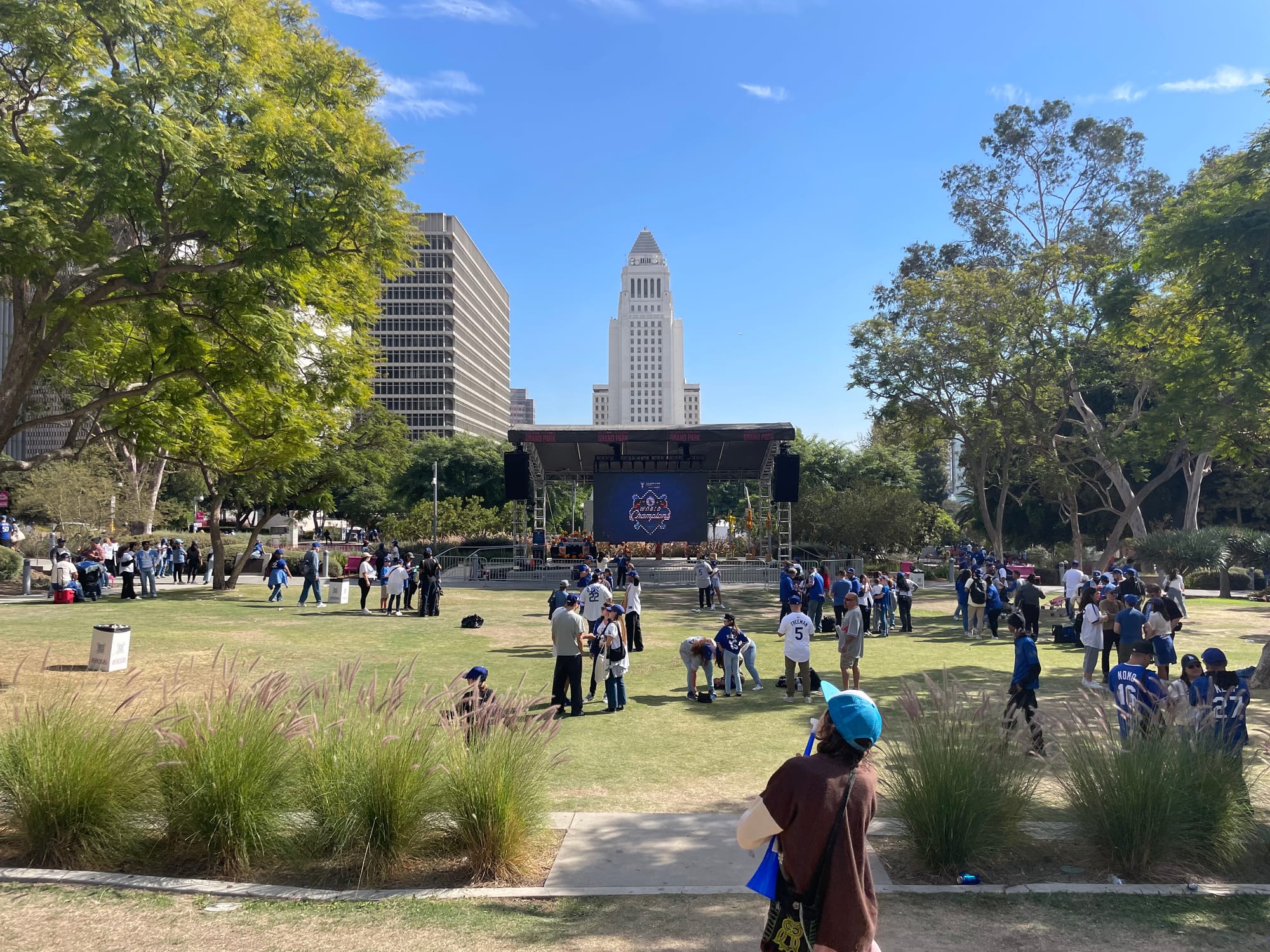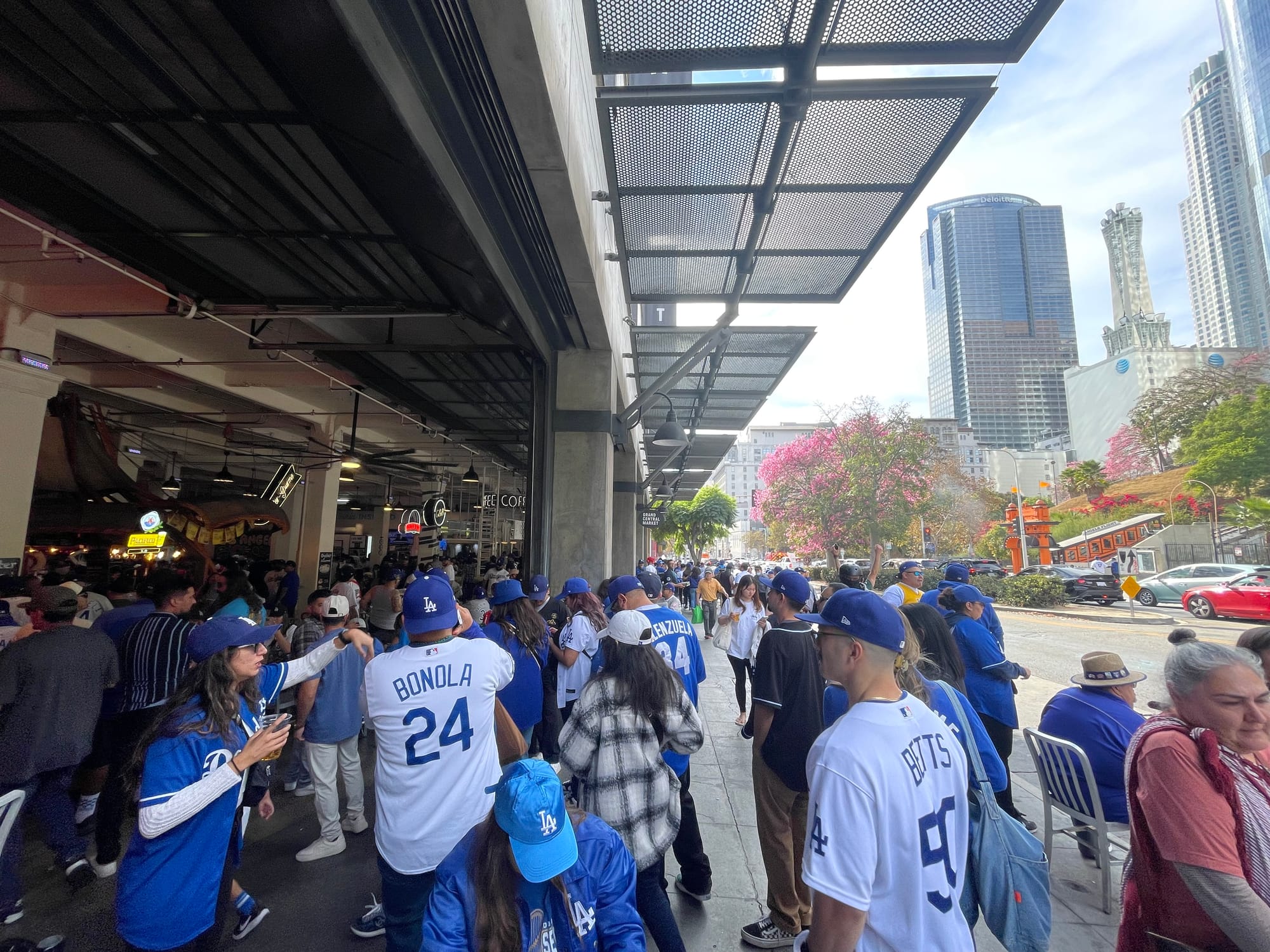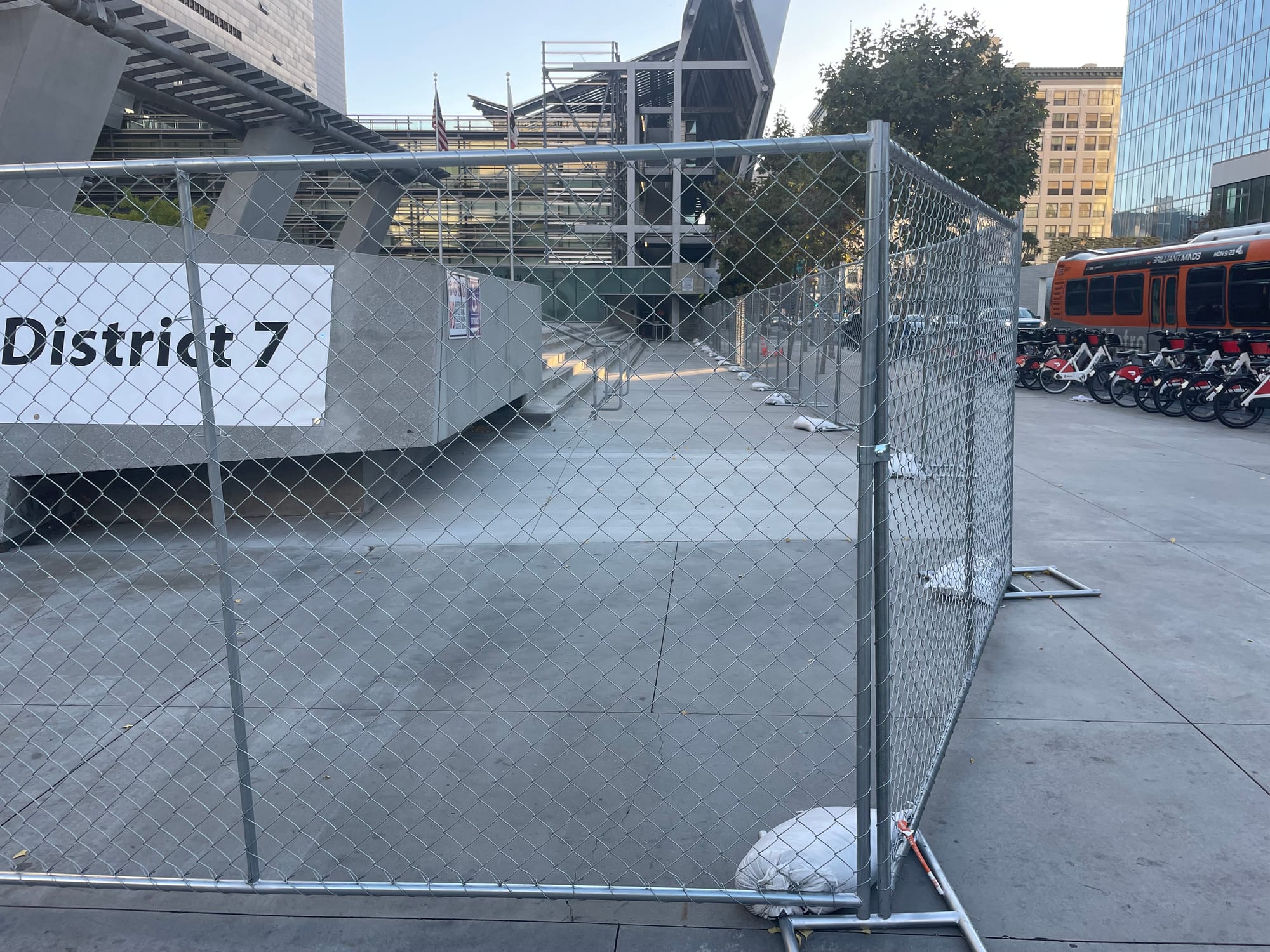The Grand scheme
This is the downtown that Frank Gehry wanted. When will LA's leaders give it to us?
How can LA come together when officials are so averse to people spontaneously gathering that the city's first reaction is to take more public space away?

On Wednesday night, Los Angeles stopped screaming just long enough to gaze up in awe. The D in the Hollywood sign had been illuminated bright blue to commemorate our World Series win, something we somehow had never thought to do in the 66 years since the Dodgers came to town. Neighbors texted each other to go outside, where many Angelenos already were, judging solely by the fireworks output. It wasn't that easy to see — and should honestly have been on for a whole week — but just knowing it was lit was surprising and delightful and approximately 500 times better than the Great HAMSYWOSE Debacle when the Rams won the Super Bowl in 2022. It turns out the sign didn't need a fussy, expensive transformation. Our triumphant D had always been there, watching over the city.
By Friday, LA was riding a sugar-high of early fall civic celebration convergence. The Dodgers couldn't possibly have picked a better day for their parade than Día de los Muertos — and somehow, it was also Fernando Valenzuela's birthday? The trains were crush-loaded with chants of "Let's go Dodgers" reverberating up the escalators as fans streamed into a Grand Park pre-strung with papel picado and dotted with altars. As I looped through the action on a Metro Bike I saw a kinetic city flooded in blue and white with orange accents on every corner: a tiny bunch of marigolds held tight against a Dodger jersey, traffic cones being lined up along a mariscos truck, a Metro bus making a right turn at the Vin Scully Avenue street sign.

The parade attendance, which LAPD expected to be 100,000, ended up being closer to 225,000, which makes me wonder how they managed to calculate a figure that was so outrageously off. The crowd estimates also didn't include the 40,000 or so people who bought tickets to the official rally at the stadium, many of whom I saw walking into downtown afterwards to join the party. That part was especially funny to me because messaging from the city claimed it would "not be feasible" to travel between the parade and the rally — "Angelenos are advised by the Dodgers that there will not be time to commute between the events" — when they really meant it would not be feasible to get there WITH A CAR. Yes, just one week after the city had urged people to avoid the "traffic nightmare" by taking transit to Dodger Stadium for the first game of the World Series, suddenly officials were pretending that transit to the stadium did not exist. And you will not be surprised to learn that the information for the ticketed rally at Dodger Stadium only included parking directions with no transit information — no, not even a note to say if the Dodger Stadium Express was running. (It was, but the South Bay shuttles were not.)
It was even more puzzling when the parade — a handful of vehicles that drove a grand total of 10 blocks incredibly fast — officially "ended" at 5th and Flower, where the double-decker buses carrying the players hightailed it to the stadium on the 110. What a missed opportunity to extend the parade route on surface streets through more neighborhoods all the way to the stadium; then again, what could be more LA than a parade that mostly takes place on a freeway?
And why was the rally at the stadium at all? In 2022, the Rams victory parade — which was also quite short, really just tootling around Expo Park — ended with public rally, all in the same place. It was curious that the city, which had heavily promoted viewing parties during the World Series as its way to provide a fan experience to those who couldn't afford tickets, didn't announce any public viewing parties for the Dodgers rally. It was, in so many ways, a classic megaevent preview: ticketholders got to hang with LA elected officials who conveniently canceled all their meetings for the day. And the rest of us were told to stay away.

While I'm sure the stadium program was very nice, and it was lovely to see so many people in the parks, the real party Friday was in the streets. I've never seen the corridor of taco tables along Sunset so slammed. Bars were serving improvised menus out open windows, with customers seated comfortably in their camp chairs from the parade at the curb. An entrepreneurial gentleman summoned cold Modelos for sale from a giant black Department of Sanitation trash can. Despite the city's best attempts to produce experiences where victories can officially be commemorated, we also need the impromptu "Not Like Us" dance party that spills into the intersection. Maybe the way for LA to avoid conflict (which did happen last Wednesday) is by figuring how to create more space for these authentic moments, so every block can become a host of its own celebration.
Because where else are we supposed to go? Our inadequate sidewalks are already riddled with hazards — I nearly ate it when my foot jammed into an empty tree well I couldn't see on a crowded stretch — and nearly every place I walked Friday I was funneled into the street at one point. (It was much easier, in general, to navigate on a bike.) When we have millions more people here, there's got to be a real plan to carve out taco corridors, make room for dance parties, and create dedicated lanes for walking and rolling — without creating a new nightmare of accessibility challenges for disabled revelers.
The situation was made even worse downtown because many public spaces which were not "authorized" for gathering had been completely fenced off, wrapped in LA's finest chain-link-and-sandbag accessories. Even the Central Library — which put out the most consistently high-quality World Series content — was closed because it was too close to the end of the parade route. Is this really our megaevent plan? To seal off everything except the ticketed venues themselves? The Dodgers may be what unites LA, but how can LA come together when officials are so averse to people spontaneously gathering that the city's first reaction is to take more public space away? It's not like we have a playbook for regularly opening a few downtown streets for the day to make it easier for tens of thousands of people to get around without cars.

And while the barriers that expanded the sidewalk during the parade were quickly removed — heaven forbid even a single car was inconvenienced — the perimeter fences erected around downtown's plazas have all been left up in anticipation of whatever happens in today's election. I wonder what the LAPD crowd estimates are for tonight? 🔥